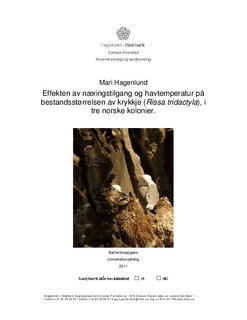Effekten av næringstilgang og havtemperatur på bestandsstørrelsen av krykkje (Rissa tridactyla), i tre norske kolonier.
Abstract
Norsk: Sjøfugl trues fra mange kanter, og den stadige nedgangen av mange av våre norske
sjøfuglarter tegner et mulig dystert fremtidsbilde. Hva som forårsaker denne nedgangen er
ikke sikkert, men flere faktorer som overfiske, bifangst i fiskeredskaper, oljeutslipp,
klimaendringer, matmangel, og en kombinasjon av disse, blir undersøkt som mulige
faktorer.
En av de artene som har hatt den mest radikale tilbakegangen er den lille pelagiske
måkefuglen, krykkje (Rissa tridactyla), som har hatt en bestandsnedgang på opptil 80 % i
noen norske hekkelokaliteter i løpet av de siste tiårene.
I denne studien har jeg forsøkt å undersøke om variasjoner i næringstilgang og
havtemperatur har hatt en effekt på bestandsstørrelsen av krykkja i Norge. For å
gjennomføre dette undersøkte jeg om det fantes en sammenheng mellom bestandstall av
tobis (Ammodytes marinus) og norsk vårgytende sild (Clupea harengus), med nedgangen
hos krykkje i tre norske kolonier: Runde, Sklinna og Vedøy/Røst. Videre undersøkte jeg
hvorvidt det fantes noen korrelasjon mellom årlige variasjoner i havtemperatur, og
bestandsvariasjoner i de tre krykkjekoloniene. Undersøkelsene ble gjort ved hjelp av
tidsserier på bestandstall av krykkje, tobis, sild, og havtemperatur fra mai måned i
tidsrommet 1980 – 2005.
Mine resultater viste en signifikant negativ effekt av økende havtemperatur på
krykkjekoloniene, og en sammenfallende signifikant negativ effekt av minkende
tobisbestand. Unntaket var kolonien Vedøy/Røst som kun viste en trend i sammenheng
med minkende tobisbestand. Når det gjaldt sammenhengen med tall av sild, fant jeg en
negativ respons i de tre krykkjekoloniene ved økende sildestamme. English: Seabirds face many different threats, and the continuing decline in many of our
Norwegian seabird species paints the picture of a grim future. The cause for this decrease
is not yet certain, but several factors, like overexploitation from fisheries, by-catch in
fishing equipment, oil spills, environmental changes, food-shortage, or a combination of
some or all of these factors, are being treated as possible factors.
One of the species that has had the most radical decrease is the small, pelagic seagull, the
black-legged kittiwake (Rissa tridactyla), which has had a population decline of up to 80
% in some norwegian colonies over the last decades.
With this study I wanted to investigate whether variations in food abundance and ocean
temperature had any effect on the Norwegian population of black-legged kittiwakes. To
do this I examined if there was a connection between population estimates for sandeel
(Ammodytes marinus), and Norwegian spring-spawning herring (Clupea harengus), with
the population size of the black-legged kittiwake in three Norwegian colonies; Runde,
Sklinna, and Vedøy/Røst, in the time period 1980-2005.
The results showed a significant decrease in the population of kittiwake, with an increase
in the population of herring, and a significant positive correlation in the colonies with
increasing amounts of sandeel. The exception was Vedøy/Røst, which only showed a
trend in correlation with sandeel abundance. The study further showed a significant
negative correlation in the population of kittiwakes with increasing ocean temperatures.
Description
Bacheloroppgave i utmarksforvaltning. Evenstad, 2011
